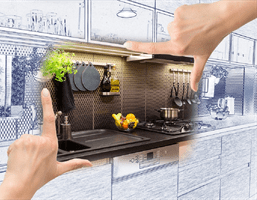
How to improve the value of your home for the long-term
For most of us, our home is by-far our biggest investment. So, if we’re going to spend more money on it for renovations, we want to make sure they’re wise expenses for the long-term. Here are four things to consider when planning your next reno.
Upgrade the kitchen
In most surveys of the best renovation projects for return on investment (ROI), kitchen renos usually top the list. It makes sense given how much time we spend in there cooking, eating and socializing. If it’s in your budget, opening-up walls and adding a kitchen island are trendy options. But a fresh coat of paint and some new handles on the drawers and cabinets are a low-cost way to refresh the most popular room in the house.
Refresh the bathrooms
Next on the list of best renos for ROI are bathrooms. Turning a dingy old bathroom with inefficient fixtures into a home-based spa will do wonders for your day-to-day life, and the home’s resale value. Some investments, such as low-flow showerheads and faucets, and water-conserving toilets are both environmentally friendly and will help lower your utility bills. Others, such as adding heated floors will have your feet thanking you for as long as you live there.
Prepare to age in place
As we start to get older and think about retirement living, most of us are planning to stay in our current homes – or, age in place. If you are planning on renovating some or all of the rooms in your house, there are some simple steps you can take to make it easier for you to stay there well into your golden years. This includes adding extra lighting, widening doorways so a walker or wheelchair can fit through and having a barrier-free shower or bathtub.
Test for radon
Your home should be your sanctuary, but some homes can house some real hazards, including radon, a cancer-causing radioactive gas. Radon is a naturally occurring gas that comes from the breakdown of uranium in the ground. In many homes, the gas can seep in and accumulate to dangerous levels. Long-term exposure to radon is the leading cause of lung cancer for non-smokers, so reducing your risk is important for your health. The first step is to test the radon level using a simple DIY kit. Then, if the level is high, you can lower it with the help of a certified professional, making your home healthier for you and increasing its value long term.
Learn more about radon, how to test for it and fix problematic levels at takeactiononradon.ca.
credit – newscanada

Leave A Comment
You must be logged in to post a comment.